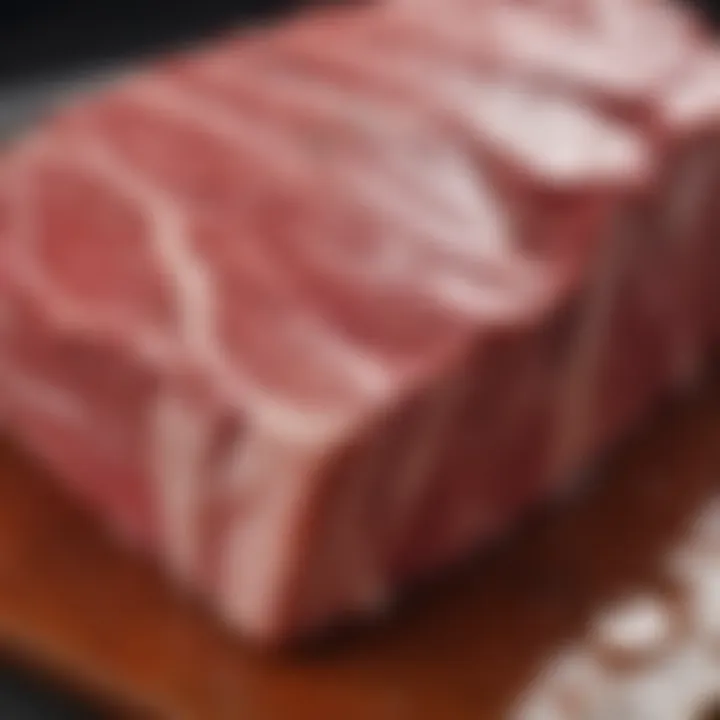Identifying the Best Beef Cut for Pot Roast


Intro
The choice of beef cut significantly influences the outcome of pot roast. Understanding different beef cuts and their characteristics is critical for crafting a dish that is flavorsome and tender. The key elements involved in these selections include marbling, the presence of connective tissues, and the duration of cooking. This guide will delve deep into these factors, providing insights into the best beef cuts for a pot roast and how to enhance their overall taste and texture.
Recipe Overview
Recipe Name
Pot Roast
Description of the Dish
Pot roast is a comforting and satisfying meal made by slow-cooking a cut of beef along with vegetables and seasonings. The process infuses the meat with flavor while rendering it tender, making it a favorite for many families.
Ingredients
- 3-4 pounds of beef chuck roast
- 1 tablespoon olive oil
- 2 cups beef broth
- 4 medium potatoes, chopped
- 3 carrots, sliced
- 1 onion, quartered
- 3 cloves garlic, minced
- 2 teaspoons thyme, dried
- Salt and pepper to taste
Special Notes on Ingredients
- Beef Chuck Roast: Ideal for pot roast due to its richness in marbling and connective tissue.
- Beef Broth: Can be substituted with vegetable broth or water, although this might alter the flavor profile.
- Seasoning Choices: Feel free to experiment with herbs like rosemary or bay leaf for added depth.
"A pot roast is only as good as the cut of meat you start with and how you prepare it."
Understanding Key Factors
Selecting the right cut of meat is not just about personal preference; it involves understanding the anatomy of the beef and how it cooks. Here are some critical components:
- Marbling: This refers to the small flecks of fat within the muscle. Cuts with higher marbling tend to be more flavorful and tender.
- Connective Tissues: Cuts with significant connective tissues break down during slow cooking, yielding a tender texture.
As we explore the best cuts for pot roast, keep these factors in mind. They will be essential in guiding you towards a successful and delectable dish.
Understanding Pot Roast
Understanding pot roast is central to mastering this classic dish. The quality of the beef cut chosen directly influences the texture and flavor of the final meal. This section delves into the essential details surrounding pot roast, highlighting what makes it a favorite among many home cooks and professional chefs alike. Knowing which cuts work best will not only enhance the taste but also ensure that the preparation process runs smoothly.
Definition and Origin
Pot roast typically refers to a method of slow-cooking beef that involves simmering it in liquid over low heat for an extended period. The goal is to create a flavorful, tender dish where the meat effectively absorbs the surrounding flavors. Its origins can be traced back to various cultures, where using tougher cuts of meat was a way to transform them into a palatable meal. This method showcases resourcefulness, as less desirable cuts become tender through the slow-cooking process. Today, pot roast is celebrated in different culinary traditions, each bringing its unique spices and ingredients.
Cooking Techniques
The methods used in cooking pot roast are crucial for achieving the desired outcome. There are several techniques that can be employed:
- Braising: This is the most common technique. It involves browning the meat first, then cooking it slowly in a liquid, often with vegetables and seasonings. The gentle heat breaks down tough connective tissues and results in a tender roast.
- Slow cooking: Utilizing a slow cooker allows for a hands-off approach. The meat simmers over several hours, absorbing flavors and becoming fork-tender.
- Pressure cooking: A quicker method that uses high pressure to soften the meat in a short time. This technique is useful for busy individuals who want to enjoy pot roast without waiting for hours.
Each cooking technique has its merits, and the choice often depends on available time and desired flavors. Regardless of the method selected, the core principle remains the same: low and slow is key.
Key Characteristics of a Good Pot Roast Cut
Choosing the right cut of beef for pot roast is not a trivial matter. Understanding the key characteristics that contribute to a successful pot roast is essential. A good cut of beef should have specific attributes that work in harmony to create a tender and flavorful dish. Two of the most significant characteristics are marbling and connective tissue. Both play roles in how a roast cooks and the overall taste of the final product.
Marbling and Flavor
Marbling refers to the small flecks of fat found within the muscle tissue of the beef. This fat is crucial for flavor and moisture retention during cooking. When a roast cooks, the marbled fat melts, basting the meat from within. The result is a more succulent roast with deep flavor profiles. A pot roast with decent marbling typically yields a better eating experience.
- Cuts like chuck roast have superior marbling when compared to leaner cuts. This richness translates into a more satisfying flavor and mouthfeel.
- Cookbook authors and chefs often recommend looking for visible marbling. The more intramuscular fat present, the better the flavor, especially when cooked slowly over time.
It’s worth noting that while marbling contributes taste, it is essential not to overlook the cut's overall fat content. A balance of fat can enhance the dish without making it greasy.
Connective Tissue and Tenderness
Connective tissue is present in various cuts of beef, particularly those that come from the shoulders and legs. This tissue breaks down during the slow cooking process. When cooked for adequate time, connective tissue transforms into gelatin, adding to the richness and mouthfeel of the pot roast.
- Cuts with higher connective tissue content will require longer cooking times to ensure tenderness. Chuck roast is an excellent example here. It is heavily marbled and has a significant amount of connective tissue, making it ideal for pot roast.
- The slow, moist cooking methods, like braising, are perfect for breaking down this tissue. As it breaks down, the meat becomes tender and flavorful.
In summary, the balance between marbling and connective tissue determines the outcome of a pot roast. Selecting cuts that excel in these areas can lead to delicious results. As such, understanding these characteristics is critical for anyone looking to create a memorable pot roast.
"A good pot roast is only as good as the cut of beef used. Prioritize marbling and connective tissue for the best results."
When considering which cut to choose, always remember the role of these key characteristics.
Top Beef Cuts for Pot Roast
Selecting the right cut of beef is crucial for a successful pot roast. The cut impacts the overall flavor, tenderness, and moisture level of the final dish. A well-chosen cut can make the difference between a lackluster meal and a rich, satisfying experience. Choosing cuts rich in marbling and connective tissue enhances the tenderness and depth of flavor as it cooks. For many, pot roast is a comforting meal, and understanding which cuts work best can elevate a simple dish into a culinary delight.
Chuck Roast
Chuck roast is perhaps the most favored cut for pot roast enthusiasts. This cut comes from the shoulder area of the cow. It possesses ample marbling, which melts as it cooks, providing moisture and flavor. Furthermore, chuck roast has a good amount of connective tissue. This breakdown during cooking contributes to the meat's tenderness, making it ideal for slow cooking methods.


When you prepare a chuck roast, it benefits greatly from long, slow cooking. This method allows the flavors to meld together beautifully while ensuring a tender texture. Many recommend searing the chuck roast prior to adding it to the pot as it can help create a deeper flavor profile in the final dish.
Brisket
Brisket is another excellent choice for pot roast. This cut is taken from the chest area of the cattle. Similar to chuck roast, brisket is well-marbled but contains a unique combination of fat and lean meat. As brisket cooks, it transforms into a rich, flavorful piece that pairs well with various seasonings and liquids.
Brisket requires a little more time to cook properly than some other cuts. Many cooks opt for methods such as braising or smoking to achieve the desired tenderness. The result is often a slice of meat that is melt-in-your-mouth tender and packed with flavor. The best preparations incorporate a dry rub or marinade prior to cooking, as this enhances the complexity of the dish.
Round Roast
Round roast may not be as widely recognized, but it can still produce an excellent pot roast. Cut from the rear leg of the animal, this piece is leaner than options like chuck and brisket. Although it lacks the same amount of marbling, it can still develop flavors through a slow-cooking process.
It is essential to monitor the cooking time carefully. Overcooking round roast can lead to a dry and less enjoyable dish. To improve flavor and moisture retention, consider marinating the cut beforehand. Incorporating a flavorful broth or gravy during the cooking process also aids in achieving a succulent meal.
Rump Roast
Rump roast is another viable option, often overlooked in favor of the more popular cuts like chuck and brisket. This cut, taken from the back portion of the cow, is relatively lean. Although it has some marbling, it possesses a firmer texture compared to other cuts. This characteristic makes it necessary to choose effective cooking methods.
Rump roast does well when cooked using moist heat methods. Braising is recommended as it encourages the breakdown of connective tissues while keeping the meat juicy. It is worth noting that adding vegetables and seasonings while it cooks can enhance the flavor significantly, making each bite delicious.
Remember: The choice of cut greatly influences the outcome of your pot roast. Consider factors such as marbling, fat content, and cooking method when selecting your beef.
Cooking Methods and Best Practices
Understanding the right cooking methods and best practices is vital for making a memorable pot roast. The way a cut is cooked significantly affects its tenderness, flavor, and overall enjoyment. Choosing the correct method can mean the difference between a tough roast and a melt-in-your-mouth masterpiece. As pot roast often involves tougher cuts of beef, selecting a cooking technique that functions well with these cuts is essential.
The two most common methods for pot roast are slow cooking and pressure cooking. Both techniques aim to break down the connective tissues and enhance the flavor profile. However, they each have unique benefits and considerations that should be taken into account when selecting the best approach.
Slow Cooking Techniques
Slow cooking is a favored method for preparing pot roast due to its ability to develop deep flavors and achieve remarkable tenderness. In this method, the meat is cooked at low temperatures over an extended period, typically in a slow cooker or a Dutch oven. This gentle cooking process allows the collagen in tougher cuts to break down, making the meat tender and juicy.
- Advantages of Slow Cooking:
- Flavor Development: Cooking slowly allows flavors to meld and intensify, enhancing the overall dish.
- Tenderness: The low heat breaks down tough fibers, resulting in fork-tender meat.
- Convenience: Once you set it up, slow cooking requires minimal attention. You can prepare other tasks while your roast simmers away.
To slow cook a pot roast effectively, it’s recommended to:
- Sear the meat: Browning the meat before placing it in the slow cooker helps develop a richer flavor profile.
- Add liquid and aromatics: Include broth, wine, or even just water along with herbs and vegetables to enhance the moisture and flavor.
- Cook on low: This generally ensures better results compared to high settings.
Pressure Cooking Options
Pressure cooking is another excellent method for making pot roast, particularly for those seeking quicker results without sacrificing flavor or tenderness. Using a pressure cooker, the surrounding steam builds pressure and raises the boiling point of water, allowing the meat to cook rapidly while remaining moist.
- Benefits of Pressure Cooking:
- Time Efficiency: Pressure cooking significantly reduces cooking time compared to traditional methods.
- Moisture Retention: The sealed environment keeps the moisture inside, resulting in juicy meat.
- Flavor Locking: The cooking process captures the flavors, allowing them to infuse the meat thoroughly.
When pressure cooking pot roast, consider these steps to yield optimal results:
- Browning the meat: Just like in slow cooking, searing the meat first enhances flavors.
- Adding sufficient liquid: Ensure there is enough liquid to create steam for proper pressure.
- Timing is crucial: Follow the recommended cooking times meticulously to avoid overcooking.
Slow cooking or pressure cooking can elevate a pot roast when best practices are followed.
Each method presents unique advantages, and the choice often depends on time constraints and personal preference. By understanding the intricacies of both slow cooking and pressure cooking, cooks can achieve a pot roast that is truly remarkable, tailored intensively to the flavors and tenderness that each method brings.
Preparation Techniques
Preparation techniques play a vital role in the overall success of a pot roast. They not only impact the flavor but also the texture of the beef. Proper preparation can enhance the dish, making it tender and flavorful. Engaging in effective trimmimg and seasoning practices sets the stage for optimal cooking results.
Trimming and Seasoning
Trimming the beef cut is an essential step before cooking. This involves removing excess fat and silverskin, which can hinder the meat's tenderness. Overly fatty cuts can lead to greasiness when prepared. A well-trimmed roast allows for better flavor absorption and improved texture during cooking.
Seasoning is equally important. Applying salt and preferred spices before cooking can significantly elevate the flavor profile of the roast. A balanced seasoning helps draw out the natural meat flavors and transforms a simple dish into a memorable one. It is wise to season the meat at least an hour before cooking. This allows time for the salt to penetrate the meat, enhancing the overall taste.
Browning the Meat
Browning the meat is a technique that shouldn’t be overlooked. It plays a crucial role in developing flavor through the Maillard reaction. This reaction occurs when meat is exposed to high heat, resulting in a rich, savory crust. The process imparts depth and complexity to the final dish.
To effectively brown the meat, begin by heating a bit of oil in a large pot or Dutch oven. Ensure the pan is hot before adding the beef. Avoid overcrowding the pan, as this can inhibit proper browning. Work in batches if necessary. Once the roast is browned on all sides, remove it and proceed with the recipe. This step adds not only taste but also appealing visual color to the dish.
Proper preparation techniques, including trimming, seasoning, and browning, make all the difference in creating an exceptional pot roast.
In summary, taking the time to focus on these techniques can elevate the humble pot roast to a stand-out meal. The initial effort will pay off through rich flavors and tender results. Each step contributes significantly to the overall dish, ensuring a rewarding cooking experience.
Enhancing Flavor Profiles
Enhancing the flavor profiles of a pot roast is crucial for achieving a dish that captivates the palate. The right combination of herbs, spices, marinades, and brines can elevate the natural taste of the beef, providing an intricate balance of flavors. It is not only about cooking the meat; it is about creating an experience that lingers. When seasoned correctly, each bite becomes a celebration of well-rounded flavors, transforming a basic meal into a culinary delight.
While cooking techniques certainly play a role, what goes into the meat beforehand can determine the overall success of the dish. Selections of herbs and spices affect how the roast interacts with heat during the cooking process. Similarly, marinades and brines introduce moisture and flavor deep into the fibers of the meat, resulting in a complete sensory experience. Understanding and utilizing these enhancing elements can significantly impact the final outcome of the pot roast.


Herbs and Spices
When choosing herbs and spices for pot roast, it is essential to consider the interacting flavors. Common options like thyme, rosemary, and bay leaves can add earthy characteristics that complement the beef. These herbs work well either fresh or dried, depending on availability and personal preference.
Moreover, if you are looking for more robust flavors, options like oregano or garlic powder can enliven the dish. The right herbs can uplift the dish, accentuating the natural umami of the beef while providing depth.
Some popular combinations include:
- Thyme and rosemary: These herbs create a classic flavor profile that works exceptionally well with pot roast.
- Garlic and onion powder: These ingredients add a savory touch that enhances the existing meat flavors.
- Paprika and black pepper: For those who want a hint of spice, paprika can offer a mild kick, and black pepper can add warmth.
It’s wise to season throughout the cooking process. Adding herbs at different stages can create layers of flavor. For instance, using some when browning the meat can give an initial seasoning, while incorporating them later in the cooking can refresh the flavor as it melds over time.
Marinades and Brines
Marinades and brines serve as both flavor enhancers and moisture holders. A good marinade typically consists of an acid, an oil, and various seasonings. The acid helps to tenderize the meat, while the oil locks in moisture, leading to a juicy final product. Consider using options like vinegar, citrus juice, or yogurt as your acid base. The oil can be olive oil or any neutral type, depending on the desired flavor.
In contrast, a brine contains salt, which ensures that the meat retains moisture during cooking. Using a brining mixture with herbs, sugar, and spices can also infuse flavors directly into the meat.
Key points for effective marinades and brines include:
- Timing: Marinating for at least a few hours, or overnight if possible, allows the flavors to infuse. Brines, on the other hand, should ideally be applied for 12 to 24 hours.
- Balance: It is vital to achieve a balance between salty, sweet, and acidic elements in your brining or marinading mixture.
"Combining the right herbs, spices, marinades, and brines not only enhances flavor but also improves the overall mouthfeel and tenderness of the pot roast, resulting in a superior dining experience."
Finding the perfect balance in enhancing flavor profiles is an art that, when executed with care, can turn a simple pot roast into a remarkable dish. The use of herbs and spices, alongside effective marinades and brines, provides numerous avenues for creativity and taste exploration.
Serving Suggestions
In any culinary creation, the serving suggestions play a pivotal role in enhancing the overall dining experience. Pot roast, with its rich flavors and tender texture, deserves to be complemented with side dishes and presentation styles that highlight its qualities. Thoughtful serving choices can elevate the dish from a simple meal to a memorable feast. This section explores various elements to consider when serving pot roast, as well as recommendations that balance flavors, textures, and aesthetics.
Complementary Side Dishes
When pairing side dishes with pot roast, the goal is to enhance the meal without overpowering the main attraction. A well-balanced plate often consists of a variety of components.
- Root Vegetables: Carrots, parsnips, and potatoes roasted alongside the pot roast absorb the meat's juices. Their sweetness creates a pleasant contrast to the savory profile of the meat.
- Green Vegetables: Adding something fresh, such as steamed green beans or sautéed spinach, introduces freshness and color to the plate. These options help balance the richness of the pot roast.
- Grains: Consider serving the pot roast with creamy polenta or fluffy mashed potatoes. Both options provide a base that can soak up the meat's juices, adding to the overall satisfaction of the meal.
- Salads: A simple green salad dressed with a light vinaigrette can awaken the palate and refresh the dining experience. Adding elements like nuts or cheese can further enhance flavors.
Presentation Techniques
The way pot roast is presented can greatly impact the enjoyment of the meal. A thoughtful arrangement can make even a humble dish look appealing.
- Plating: Use a large platter to present whole cuts of pot roast, slicing it just before serving. This preserves moisture and enhances visual appeal. Arrange the vegetables artfully around the meat, ensuring vibrant colors are displayed.
- Garnishes: Fresh herbs such as parsley or thyme can add a dash of color and freshness. A sprinkle of these herbs just before serving not only looks appealing but also adds a subtle flavor.
- Serving Temperature: Serve the pot roast warm, as this enhances tenderness and flavor. Ensure that side dishes are also heated through, to provide a comforting experience.
- Creative Serving Bowls: By using unique serving dishes, similar as rustic ceramic bowls for sides, the meal can gain a rustic charm. These thoughtful choices enhance the dining atmosphere.
"The art of serving is as important as the art of cooking. Presentation engages all senses, making a meal more enjoyable."
Common Mistakes to Avoid
Selecting the right cut of beef for pot roast is crucial, but so is the cooking process itself. Many home cooks make simple yet impactful mistakes that can compromise the dish. This section addresses two common pitfalls: under-seasoning the meat and overcooking the roast. Understanding these errors can significantly improve the quality of your pot roast, enhancing both flavor and texture.
Under-seasoning the Meat
One prevalent mistake when preparing pot roast is under-seasoning the meat. Proper seasoning is essential. It not only enhances the flavor but also elevates the overall dining experience. Many cooks mistakenly think that the beef's natural flavor is enough. While good quality meat does have inherent taste, seasoning can bring out those flavors in a profound way.
To avoid this mistake, consider the following:
- Salt is your primary tool. It should be generously applied on all sides of the meat before cooking. This will help to draw out moisture and concentrate flavors.
- Herbs and spices can add depth. Using garlic powder, onion powder, or fresh herbs like rosemary and thyme can transform your pot roast.
- Don't forget about marinades. Marinating the meat for several hours, or preferably overnight, can significantly enhance flavor and tenderness.
Understanding that seasoning is a fundamental part of cooking will prepare you for a more satisfying pot roast.
Overcooking the Roast
The second major error is overcooking the roast. This often stems from misunderstanding the required cooking times or not keeping an eye on internal temperature. Overcooked beef turns tough and loses its intended flavor. It’s vital to find the right balance between cooking time and temperature.
To achieve a perfectly cooked pot roast, follow these tips:
- Use a meat thermometer. Aim for an internal temperature of around 190°F to 205°F. This range allows the connective tissues to break down without drying out the meat.
- Monitor cooking time throughout the process. If you are using a slow cooker, for example, check progress periodically to ensure it is not cooking too fast.
- Consider using a lid during cooking to retain moisture. Without it, the meat may dry out more quickly than anticipated.
By being vigilant about these two common mistakes, you can dramatically enhance both the flavor and texture of your pot roast.
"Understanding and avoiding common cooking mistakes can lead to a more satisfying and flavorful meal."
Storage and Leftover Management
Effective storage and management of leftovers is critical when preparing pot roast. Not only does it ensure food safety, but it also helps to retain flavors and textures for future meals. For many, pot roast is a labor of love, and preserving that quality is essential.
When you have a significant amount of pot roast left over, consider refrigerating it within two hours of cooking. This is to minimize the risk of bacteria growth. The first step involves proper cooling techniques that are vital.
Proper Cooling Techniques
To cool your pot roast safely, slice it into smaller portions. This allows the meat to cool more rapidly. Placing the portions in shallow containers can help as well, as it increases the surface area exposed to cooler air. It is important to cover the containers with lids or plastic wrap to prevent contamination. The ideal temperature for refrigerating cooked meat should be at or below 40°F (4°C). Ensure your refrigerator runs efficiently to maintain these temperatures, avoiding a breeding ground for harmful bacteria.
Always practice safe cooling and storage methods to preserve the quality of your pot roast.


Reheating Methods
When reheating leftover pot roast, the main goal is to restore its moisture and flavor. There are several methods to achieve this:
- Oven Method: Preheat your oven to 350°F (175°C). Place the pot roast in a roasting pan, add a splash of broth or water to maintain moisture, and cover it with aluminum foil. Heat for about 20-30 minutes or until it reaches a safe internal temperature of 165°F (74°C).
- Stovetop Method: You can reheat your pot roast in a skillet on medium heat. Add broth or water, cover, and let it simmer on low until heated through. Stir occasionally to prevent sticking.
- Microwave Method: Cut the pot roast into smaller pieces and place it in a microwave-safe dish. Add a bit of broth or water, cover loosely, and heat on medium power. Check every minute to avoid overcooking.
Storing and reheating leftover pot roast properly not only minimizes waste but also allows you to enjoy the dish multiple times. Maintaining quality and safety are the main aspects to always consider in this process.
Nutritional Considerations
Understanding the nutritional aspects of beef cuts for pot roast is vital. This section will shed light on the key components of beef, particularly focusing on protein and fat content. It will also encompass the health considerations associated with consuming these cuts. A proper balance of nutrition enhances not only the flavor but also the overall health benefits of the dish you create.
Protein Content
Beef is a rich source of protein, which is crucial for various bodily functions. One typical serving of a pot roast contains significant protein, contributing to muscle repair and growth. Pot roast cuts like chuck and brisket provide about 20 to 25 grams of protein per 3-ounce serving. This makes it a favorable choice for those seeking to meet their daily protein requirements.
Moreover, protein from beef supports satiety, leading to a more fulfilling meal. Combined with other nutrients in the pot roast, such as vegetables, it provides a balanced approach to nutrition. Adequate protein intake is especially important in the diets of both active individuals and those recovering from illness.
Fat Content and Health Aspects
The fat content in beef cuts varies, and understanding this variability is essential for health-conscious consumers. Cuts like brisket can have higher fat content, offering flavorsome results. However, lean cuts, such as round roast, provide options for those wanting to minimize fat intake.
Considering the types of fat present in beef:
- Saturated Fat: Linked to elevated cholesterol levels if consumed excessively. It is advisable to consume fattier cuts in moderation.
- Monounsaturated Fat: Often deemed a heart-healthy fat, present in varying levels in beef, potentially beneficial for heart health.
Moreover, certain cuts of beef also supply essential vitamins and minerals, such as B12, iron, and zinc. These nutrients play significant roles in functions like energy production and immune support. Choosing the right cut can help in balancing flavor, nutrition, and health considerations.
"The nutritional profile of pot roast cuts not only contributes to a satisfying meal but also to long-term health benefits when consumed mindfully."
In summary, when selecting beef cuts for pot roast, take into account both the protein richness and varying fat content. This helps in crafting a dish that pleases the palate and aligns with your nutritional goals.
Cultural Variations in Pot Roast
Understanding cultural variations in pot roast enriches the culinary experience by showcasing how different societies prepare and enjoy this classic dish. Each culture presents its unique twist, reflecting local ingredients and preferences. Such variations contribute to the broader appeal of pot roast, making it a versatile and globally recognized meal.
Regional Differences
Regional differences significantly influence how pot roast is made. In the United States, particularly in the Midwestern region, pot roast is often prepared using chunks of chuck roast. It is slow-cooked in a mixture of broth and vegetables, creating a comforting dish, especially on colder days.
In contrast, in some parts of France, such as Provence, the dish might incorporate herbs de Provence and be braised with red wine. This adds a layer of complexity to the flavor profile and emphasizes the importance of local culinary practices.
Each region paints a different picture. Here’s a brief overview:
- USA: Typically uses beef chuck with carrots and potatoes.
- France: Often braised with wine and herbs;
- Italy: Sometimes features tomato-based sauces and regional herbs;
- Asia: Can include soy sauce and ginger, adapting to local palates.
Such distinctions reflect various cooking methods and ingredients available in each culture, making pot roast a customizable and adaptable dish.
Traditional Preparations Around the World
Traditional preparations of pot roast reveal how this meal transcends boundaries. In Irish cuisine, the dish may utilize stout beer, enhancing the flavor with a distinct richness that mirrors the nation’s culinary heritage. In contrast, Spanish versions might include spices like paprika and be served alongside a more robust sauce.
Interestingly, in some South American countries, pot roast could be prepared with special local spices and served with rice or beans, showcasing a far more diverse approach.
Here are a few traditional preparations:
- Irish: Uses stout for braising,
- Spanish: Incorporates paprika and local spices,
- Brazilian: Often features rice and beans with regional spices.
Each of these methods underscores how pot roast is not just a dish but an experience that varies greatly across geographic and cultural lines.
In essence, the cultural diversity in preparing pot roast reflects both adaptation and creativity, showcasing local ingredients while honoring tradition.
This exploration of pot roast variations offers insights that can inspire cooks to experiment in their kitchens, blending flavors and techniques from different cultures.
Final Thoughts on Pot Roast Selection
Selecting the right beef cut for pot roast is a critical decision that impacts the overall success of the dish. The right cut contributes not only to the flavor but also to the tenderness and enjoyment of the meal. For anyone interested in perfecting their pot roast, understanding the nuances of each cut is essential.
Balancing Quality and Cost
When it comes to choosing beef cuts for pot roast, there is often a fine line between quality and cost. Premium cuts like chuck roast might come at a higher price, yet they often deliver superior flavor and texture due to their marbling and connective tissue. Cheaper cuts can be tempting, but they may not yield the same results. Therefore, it is important to assess the intended outcome of your pot roast experience.
A practical approach involves:
- Evaluating your budget: Determine how much you are willing to spend.
- Researching cuts: Compare the flavor profiles and tenderness of various cuts relevant to your budget.
- Assessing cooking methods: Some cuts benefit from slow cooking methods; others may not need such long cooking times.
By balancing these factors, you can opt for the best cut within your price range while ensuring a memorable pot roast.
The Importance of Sourcing
Understanding where your meat comes from is vital to making informed choices. Sourcing affects quality, flavor, and even ethical considerations. Sourcing from local farms or trusted suppliers can lead to fresher cuts with better flavor and nutrients.
Consider these factors when sourcing your beef:
- Local versus industrial sources: Local farms may offer better quality and animal welfare, which are often reflected in taste.
- Grass-fed versus grain-fed: Grass-fed beef is known for its distinct flavor. Grain-fed may be more tender due to higher fat content.
- Organic options: Organic practices can matter depending on your dietary choices and health considerations.
"The quality of the ingredients directly impacts the dish. Choose wisely."







